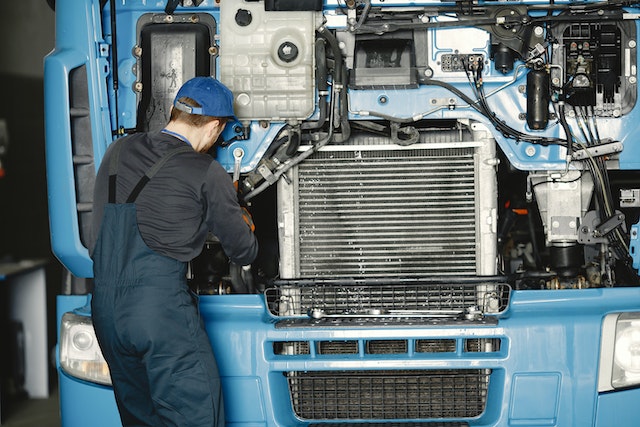The commercial trucking industry is a vital part of the US economy. Trucks move around 72% of all goods in the country. Starting a semi-truck business can be an excellent opportunity!
With the proper preparation and planning, a semi-truck business can be a successful and rewarding venture.
Let’s talk about how to start a semi-truck business.
Semi Truck Business Success | 8 Steps
Step 1: Research The Semi Truck Industry
Before you start a trucking company, it’s crucial to research the industry and understand the market. Look at the trends, the competition, and the potential customers. Understanding the industry will help you make informed decisions and ensure your business is booming.
For example, when researching the industry, you can start by looking at the current market trends. This can include investigating the demand for trucking services in different regions, the commonly transported goods, and the current rates for trucking services.
By conducting this research, you can better understand the industry and the market. You will be able to identify potential opportunities and challenges and make informed decisions about your business strategy.
Step 2: Create a Semi Truck Business Plan
Once you understand the industry well, the next step is to create a business plan. A business plan should outline your goals and strategies, and the steps you need to take to achieve them. It will also help you secure funding and attract investors.
A trucking company business plan should include the following key elements:
- Executive Summary: A summary of the main points of the business plan, including the purpose of the business, the target market, and the critical strategies for achieving success.
- Company Description: A description of the company, including the legal structure, ownership, and management team.
- Market Analysis: An analysis of the industry, including the current market trends, the competition, and the potential customers.
- Services: A description of the services that the business offers, including the types of goods that will be transported and the routes that will be covered.
- Marketing and Sales: A description of the marketing and sales strategies, including the target market, pricing strategy, and promotional activities.
- Operations: A description of the day-to-day operations of the business, including the logistics of transporting goods, the maintenance of the vehicles, and the management of the drivers.
- Financial Projections: Financial projections for the business, including income statements, balance sheets, and cash flow statements from your business bank account.
Step 3: Obtain The Necessary Licenses And Permits
Starting your own trucking business requires obtaining the necessary licenses and permits. These include a commercial driver’s license and the authority to operate as a motor carrier.
For example, you will need to obtain several licenses and permits to operate a semi-truck business. These may include:
- Federal Motor Carrier Safety Administration (FMCSA) Operating Authority: This is also known as an MC number. This is required for any company that operates commercial vehicles transporting goods in interstate commerce.
- USDOT Number: This is a unique number assigned by the FMCSA to identify commercial motor carriers.
- State Operating Permits: Some states also require a separate permit to operate within their borders.
- Commercial Driver’s License (CDL): Drivers operating commercial vehicles, including semi-trucks, must have a CDL.
- Vehicle Registration: Each vehicle used in the business must be registered with the state and have proper business insurance.
It’s important to note that the requirements for obtaining licenses and permits may vary depending on the state. It’s also crucial to comply with federal and state regulations regarding safety, insurance, and other operational standards.
Step 4: Secure Funding
Starting a semi truck business requires a significant financial investment, and securing funding is crucial.
Consider options such as traditional bank loans, equipment financing, or working with a lender specializing in the trucking industry.
Mission Financial Services is a preferred loan process agent for national and regional dealership chains and family-owned, independent, and franchised dealerships. They also offer loans to first-time buyers and loans to those with bad credit scores.
For example, if you want to start a semi-truck business with five trucks, you will need to purchase or lease the trucks, trailers, and other equipment. Additionally, you will need to pay for insurance, maintenance, and other expenses.
Starting the business may cost a significant amount, which may not be feasible to cover with personal savings or credit cards. In this case, you’ll need to secure funding through a loan or other financing options.
Working with a lender specializing in the trucking industry, such as Mission Financial Services, can be helpful. They understand the specific needs and challenges of the trucking industry.
They may also offer financing options tailored to the needs of trucking businesses, such as loans for purchasing or leasing trucks and trailers or loans for covering operating expenses.
Step 5: Purchase Or Lease Trucks And Trailers
Once you have secured funding, focus on purchasing or leasing trucks and trailers. When it comes to purchasing or leasing trucks and trailers, there are pros and cons to each option.
Purchasing
Pros
- Ownership: When you purchase a truck or trailer, you own it outright and have the flexibility to customize it to your business’s specific needs.
- Equity: As you pay for a purchased truck or trailer, you build equity in the equipment.
- Tax deductions: You can take advantage of tax deductions for the equipment, such as depreciation.
Cons
- Upfront cost: Purchasing trucks and trailers requires a significant upfront investment, and it may not be feasible for businesses with limited capital.
- Maintenance costs: As the trucking business owner, you are responsible for all maintenance and repairs, which can be expensive.
- Depreciation: The value of the equipment will depreciate over time, which can impact the resale value.
Leasing
Pros
- Lower upfront cost: Leasing requires a smaller upfront investment than purchasing, making it more accessible for businesses with limited capital.
- Lower maintenance costs: Maintenance and repairs are often included in the lease agreement, saving money on maintenance costs.
- Flexibility: Leasing allows you to upgrade to newer equipment more frequently, which can benefit businesses that need to keep up with new technology or regulations.
Cons
- Lack of ownership: When you lease equipment, you don’t own it outright and may not have the flexibility to customize it to your business’s specific needs.
- Limited equity: As you make payments on a leased truck or trailer, you don’t build equity in the equipment.
- Higher costs in the long run: Leasing equipment over an extended period can cost more in the long run than purchasing it outright.
Consult with a transportation consultant or financial advisor to help evaluate your options and make the best decision for your business.
Step 6: Hire Drivers
Even as an owner-operator, a semi-truck business relies heavily on its drivers. Hiring qualified, professional drivers who can ensure the safe and efficient transportation of goods is essential. When hiring drivers, consider the following qualities:
- Commercial driver’s license (CDL): Drivers operating commercial vehicles, including semi-trucks, must have a CDL.
- Driving experience: Look for drivers with experience driving semi-trucks and a good driving record.
- Knowledge of federal and state regulations: Drivers must be familiar with federal and state laws regarding transportation, including hours of service, inspection, and maintenance requirements.
- Communication skills: Drivers must communicate effectively with dispatchers, customers, and other drivers.
- Problem-solving skills: Drivers must be able to handle unexpected situations and make quick decisions.
- Physical stamina: Driving a semi-truck can be physically demanding, and drivers must be able to handle the job’s demands.
- Professionalism: Drivers and owner-operators must professionally conduct themselves and be able to represent the company in a positive light.
- Safety-minded: Drivers must prioritize safety and follow safety protocols and regulations.
Step 7: Build A Strong Network
Building a solid network of contacts and relationships can benefit your business in the trucking industry.
Here are a few ways to build a strong network:
- Join industry associations: Joining industry associations such as the American Trucking Association (ATA) can provide opportunities to connect with other trucking professionals and stay informed about industry trends and regulations.
- Partner with other trucking companies: Consider partnering with other trucking companies to share resources and pool expertise.
- Develop a good relationship with suppliers: Building a strong relationship with suppliers will help you keep costs down and deliver the goods on time.
- Provide excellent customer service: Building a solid relationship with customers can lead to repeat business, positive word-of-mouth, and new business opportunities.
Connecting with other trucking companies, suppliers, manufacturers, distributors, and customers can help you gain new business, improve logistics, and stay informed about industry trends and regulations.
Step 8: Keep Accurate Records
Keeping accurate records is essential for the success of a semi-truck business. Here are a few benefits of keeping accurate records:
- Financial tracking: Accurate record-keeping can help you track your income and expenses and monitor the financial performance of your business. You can use this information to make informed decisions about your business and plan for future growth.
- Compliance with regulations: Keeping accurate records can help you ensure compliance with federal and state laws. This includes keeping track of service hours, vehicle maintenance and inspection records, and driver qualifications.
- Taxes: Accurate record-keeping can help you file taxes correctly and take advantage of tax deductions.
- Auditing: Accurate record-keeping is essential. You may be subject to an audit by the Federal Motor Carrier Safety Administration (FMCSA) or other regulatory bodies.
- Efficiency: Accurate records can help you improve the efficiency of your business. It does this by allowing you to track inventory and deliveries and manage staff and vehicles more effectively.
Final Thoughts
Starting a trucking company requires significant time, money, and effort. Still, it can be a successful and rewarding venture with the proper preparation and planning.
By following these steps and making informed decisions, you can start a semi-truck business that will thrive in the competitive commercial trucking industry in the US.
If you want to start your own trucking company, don’t hesitate to reach out to Mission Financial Services for loans and financing options.









